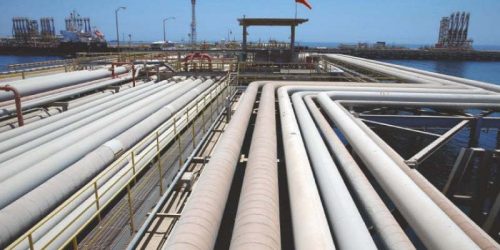LAHORE: The dispute between the state-owned gas companies and sponsors of the two proposed private LNG terminals — Tabeer and Energas — over pipeline capacity allocations for the projects will likely linger for a much longer period than anticipated by the investors.
While the investors are looking for firm commitments from Sui Sothern Gas Company (SSGC) and Sui Northern Gas Pipelines Limited (SNGPL) over allocation of gas pipeline capacity before they start work on the construction of the two terminals at Port Qasim, the gas companies argue they are not bound to allocate pipeline capacity before projects completion under the February decision of a committee on LNG pipeline capacity allocation, which had been constituted by the Cabinet Committee on Energy (CCoE).
A senior Energas executive, who wants to stay anonymous, told Dawn on Saturday that both Tabeer and Energas had requested the SSGC and SNGPL to allocate to them pipeline capacity equal to just 40pc of their combined terminal capacity of 1,500 million cubic feet a day (mmcfd). “Both SSGC and SNGPL have rejected our request, saying they didn’t have spare capacity,” he said.
He claimed that both SSGC and SNGPL had between 400 and 600mmcfd capacity to spare and allocate to the new terminals. “This capacity can also be increased through a swap arrangement under which the gas companies would allow LNG brought by private terminals in place of the system gas,” he said. However, SSGC and SNGPL want them to bear the cost of 10-18pc UFG (unaccounted for gas) losses against the 6pc losses determined by Ogra.
Tabeer and Energas were granted a licence to undertake regulated activity related to the sale of re-gasified liquefied natural gas (RLNG) in Pakistan in January 2021. The last steps before the two RLNG firms commenced development of the terminals include construction licences from Ogra and the regulator and gas transportation agreements with the two gas utilities.
Ogra has already organised a public hearing on Monday in Karachi, which will expedite the grant of construction development licences to the investors for the establishment of the terminals including allied facilities. Nonetheless, the terminal developers have long been accusing the state gas utilities of creating roadblocks in the development of their projects. Both the private projects with RLNG capacity of 750mmcfd to 1000mmcfd each are scheduled to come online in two years during the first quarter of 2023.
However, the gas companies have a different story to tell.
“The February CCOE decision on spare existing pipeline capacity allocation to the terminals has three parts. One, Ogra can allocate spare capacity on a three-month rolling basis on the ‘as and when available’ basis (during lean demand months from May to September). Two, the spare capacity in the existing system will be allocated to the new terminals after their completion against their indicated requirement. If the indicated requirement is greater than the spare capacity, both of them will get equal allocation. These are short-term measures though,” a gas company official told Dawn.
The longer-term, permanent allocation of capacity suggested by the CCOE was the allocation of full required capacity to the private terminals only after the completion of the North-South pipeline, he said. The gas official wondered as to why the developers were in a hurry to get pipeline capacity allocations.
“The government has promised them to provide capacity once they become operational in 2023. They should have confidence in the government as it is making arrangements for the completion of the new pipeline before 2023,” the official said.
With Pakistan becoming one of the fastest growing LNG markets since it imported its first cargo in 2015, the industry sources say there is an urgent need to expand import capacity expansions to meet the increasing future imported gas demand. The two projects intend to bring LNG for private power, cement, textiles, fertilizer and other companies through a floating storage and re-gasification unit (FSRU). Currently, Pakistan has two LNG terminals with a combined capacity of 1350mmcfd though the capacity of both terminals has been contracted by the government.





